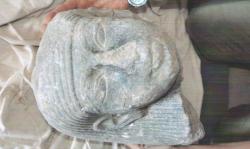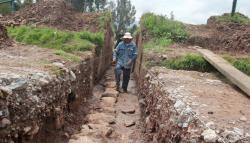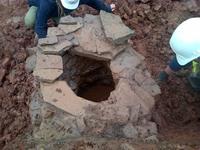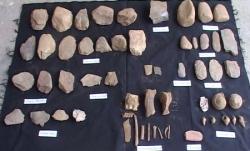INSTITUT SUPERIEUR D'ANTHROPOLOGIE
INSTITUTE OF ANTHROPOLOGY
ONLINE COURSES / COURS A DISTANCE
WINTER TERM : JANUARY 2014
REGISTER NOW
EGYPTE –  Deir el Bahari - The Egyptian-Spanish archaeological mission unearthed on Thursday a large granite head of a statue of an unidentified New Kingdom king during routine excavation at King Thutmose III’s funerary temple on Luxor’s west bank.Mohamed Abdel-Maqsoud, head of the Ancient Egyptian Antiquities Section at the Ministry of State for Antiquities (MSA), explained that the head is 29.6cm high, 24.3cm wide and 26.9cm deep. The head depicts a round face of a royal figure, not identified yet, wearing a wig, with traces of a broken nose, and two long ears that each reach 8cm. The eyes, he continued, have traces of kohl, with thick eyebrows.Abdel-Maqsoud said that the head was found buried in sand in a pit on the northern side of the second court of the temple. Studies are underway in an attempt to determine which New Kingdom king it belongs to. The temple of Thutmose III is a vey small temple located beside the temple of Queen Hatshepsut at Al Deir Al-Bahari. It was first discovered in February 1962 during routine restoration work carried out by a Polish excavation mission of the Polish Centre of Mediterranean Archaeology led by archaeologist Kazimierz Michalowski. The temple is poorly preserved and was dedicated to god Amun-Re. Although Thutmose III’s actual funerary temple Henkhet-Ankh is located a short distance away, such a temple had played some role within the king’s funerary cult.
Deir el Bahari - The Egyptian-Spanish archaeological mission unearthed on Thursday a large granite head of a statue of an unidentified New Kingdom king during routine excavation at King Thutmose III’s funerary temple on Luxor’s west bank.Mohamed Abdel-Maqsoud, head of the Ancient Egyptian Antiquities Section at the Ministry of State for Antiquities (MSA), explained that the head is 29.6cm high, 24.3cm wide and 26.9cm deep. The head depicts a round face of a royal figure, not identified yet, wearing a wig, with traces of a broken nose, and two long ears that each reach 8cm. The eyes, he continued, have traces of kohl, with thick eyebrows.Abdel-Maqsoud said that the head was found buried in sand in a pit on the northern side of the second court of the temple. Studies are underway in an attempt to determine which New Kingdom king it belongs to. The temple of Thutmose III is a vey small temple located beside the temple of Queen Hatshepsut at Al Deir Al-Bahari. It was first discovered in February 1962 during routine restoration work carried out by a Polish excavation mission of the Polish Centre of Mediterranean Archaeology led by archaeologist Kazimierz Michalowski. The temple is poorly preserved and was dedicated to god Amun-Re. Although Thutmose III’s actual funerary temple Henkhet-Ankh is located a short distance away, such a temple had played some role within the king’s funerary cult.
http://english.ahram.org.eg/NewsContent/9/40/90118/Heritage/Ancient-Egypt/An-unidentified-royal-head-found-in-Luxor.aspx
PEROU -  Sacsayhuaman - Archaeologists in Cusco announced a new discovery this week: an Inca canal where servants used to get water for the head of the empire during the Inti Raymi celebration. The canal was uncovered in the Sacsayhuaman archaeological complex, above the city of Cusco. Two months ago, archaeologists began to excavate an area near the Calispuquio sector of Sacsayhuaman when they noticed water filtering through the ground. What they uncovered was a 16-meter long canal that measures 15 centimeters wide and a meter deep.The canal is in the visitors parking and access area of the archaeological park, but it has not been damaged by vehicles because it lies one and a half meters underground. Park management are planning the immediate relocation of a visitors’ access area. The Inca canal was believed to have transported water from a spring in the Rinconada district, on the northern edge of Sacsayhuaman.The head of the Sacsayhuaman park, Oscar Montufar, said that the canal was used by servants to get water for the Inca during Inti Raymi, the empire’s most important religious ceremony in which it paid homage to Inti, the all-important sun god. It was also used to fill the baths for the young winners of the Warachicuy initiation ceremony. Montufar said the canal is mentioned in the chronicles by Spaniard Juan Polo de Ondegardo y Zárate, published in 1571, and its use was continued during Colonial times.
Sacsayhuaman - Archaeologists in Cusco announced a new discovery this week: an Inca canal where servants used to get water for the head of the empire during the Inti Raymi celebration. The canal was uncovered in the Sacsayhuaman archaeological complex, above the city of Cusco. Two months ago, archaeologists began to excavate an area near the Calispuquio sector of Sacsayhuaman when they noticed water filtering through the ground. What they uncovered was a 16-meter long canal that measures 15 centimeters wide and a meter deep.The canal is in the visitors parking and access area of the archaeological park, but it has not been damaged by vehicles because it lies one and a half meters underground. Park management are planning the immediate relocation of a visitors’ access area. The Inca canal was believed to have transported water from a spring in the Rinconada district, on the northern edge of Sacsayhuaman.The head of the Sacsayhuaman park, Oscar Montufar, said that the canal was used by servants to get water for the Inca during Inti Raymi, the empire’s most important religious ceremony in which it paid homage to Inti, the all-important sun god. It was also used to fill the baths for the young winners of the Warachicuy initiation ceremony. Montufar said the canal is mentioned in the chronicles by Spaniard Juan Polo de Ondegardo y Zárate, published in 1571, and its use was continued during Colonial times.
http://www.peruviantimes.com/23/archaeologists-uncover-16-meter-long-inca-canal-outside-cusco/21027/
ROYAUMME UNI –  Emerson’s Green -The remains of a major Roman villa site have been discovered by archaeologists working at a new Taylor Wimpey development site near Bristol.The team was astounded to unearth a large high-status Roman villa site and industrial buildings which covered a total area of four hectares. Finds included a large quantity of jewellery, including bronze brooches, babies’ bracelets, rings and necklaces, as well as high-status pottery. The dig also revealed the remains of cremations and burials at the site and soil samples suggest there used to be metal working and textile dying carried out in the industrial buildings.Helen Martin-Bacon, Regional Director for Wardell Armstrong Archaeology and the lead archaeologist on the project, says: “This was a very unexpected find. Helen believes the site dates back as far as Neolithic times and was occupied throughout the Iron Age and into the Roman period. She says: “The site was not as well-preserved as you would expect but it is certainly very significant.
Emerson’s Green -The remains of a major Roman villa site have been discovered by archaeologists working at a new Taylor Wimpey development site near Bristol.The team was astounded to unearth a large high-status Roman villa site and industrial buildings which covered a total area of four hectares. Finds included a large quantity of jewellery, including bronze brooches, babies’ bracelets, rings and necklaces, as well as high-status pottery. The dig also revealed the remains of cremations and burials at the site and soil samples suggest there used to be metal working and textile dying carried out in the industrial buildings.Helen Martin-Bacon, Regional Director for Wardell Armstrong Archaeology and the lead archaeologist on the project, says: “This was a very unexpected find. Helen believes the site dates back as far as Neolithic times and was occupied throughout the Iron Age and into the Roman period. She says: “The site was not as well-preserved as you would expect but it is certainly very significant.
http://www.easier.com/119551-roman-villa-remains-unearthed-taylor-wimpeys-emersons-green-site.html
CHINE –  Xi'an - A new archeological discovery has shown that the sculptured Terracotta soldiers, created to look after Qin Shihuang, founding emperor of the Qin Dynasty, in his afterlife, had armor and helmets made of stone for protection. Archaeologists believe that they have unearthed an underground armory in Xi'an, the capital of Shaanxi province at Shihuang's mausoleum. Zhang Weixing , deputy director of the museum's archaeology department, told the China Daily that every flake of the stone armor is linked by thin bronze strands and it can roll and flex, providing free movement for the soldiers who wore it. Weixing asserted that every stone flake has a different radian, meeting the contours of the wearer's face, and the part of the helmet near the wearer's shoulder has a curved recess, matching the structure of the human body. Archaeologists' examination of the helmets shows that it would have taken a person, working eight hours a day, between 344 and 444 days to complete a piece of armor with 600 stone flakes. Weixing said that there are more than 5 million flakes in the pit, and the manufacture of the stone armor and helmets required a huge amount of labor in ancient times Researchers said the texture and the production technique of the newly discovered relics is much more sophisticated than Terracotta Warriors and Horses because they were mainly made from leather during the Shang Dynasty, Western Zhou Dynasty and Eastern Zhou Dynasty. The stone armor and helmets made in the Qin Dynasty using advanced manufacturing techniques will provide significant information for studying social and technical developments in ancient times, experts added.
Xi'an - A new archeological discovery has shown that the sculptured Terracotta soldiers, created to look after Qin Shihuang, founding emperor of the Qin Dynasty, in his afterlife, had armor and helmets made of stone for protection. Archaeologists believe that they have unearthed an underground armory in Xi'an, the capital of Shaanxi province at Shihuang's mausoleum. Zhang Weixing , deputy director of the museum's archaeology department, told the China Daily that every flake of the stone armor is linked by thin bronze strands and it can roll and flex, providing free movement for the soldiers who wore it. Weixing asserted that every stone flake has a different radian, meeting the contours of the wearer's face, and the part of the helmet near the wearer's shoulder has a curved recess, matching the structure of the human body. Archaeologists' examination of the helmets shows that it would have taken a person, working eight hours a day, between 344 and 444 days to complete a piece of armor with 600 stone flakes. Weixing said that there are more than 5 million flakes in the pit, and the manufacture of the stone armor and helmets required a huge amount of labor in ancient times Researchers said the texture and the production technique of the newly discovered relics is much more sophisticated than Terracotta Warriors and Horses because they were mainly made from leather during the Shang Dynasty, Western Zhou Dynasty and Eastern Zhou Dynasty. The stone armor and helmets made in the Qin Dynasty using advanced manufacturing techniques will provide significant information for studying social and technical developments in ancient times, experts added.
http://www.aninews.in/newsdetail9/story146697/qin-dynasty-039-s-soldiers-had-039-sophisticated-039-stone-armor-for-protection.html
NEPAL - Tanahusur Durbar - A five-member team from the Department of Archaeology has completed its preliminary stage of excavation at the Tanahusur Durbar area. The team under Bhaskar Gyawali has found one-metre tall wall of the old Durbar, a yard, wares, military tower, bricks, and tundals (wooden struts) during the excavation, former chairman of Tanahu District Development Committee, Ram Chandra Pokharel, informed today. It has also identified the site for the second phase excavation, he added. According to historians, Sen kings had made the Tanahusur Durbar their seat of power and ruled from there. The excavation is an initiative of Bhanu Shanti Nikunj Tanahu meant to help preserve ancient objects. The team has made the findings public to the locals. Earlier, director at the Department of Archaeology had visited the site. Many important historical artifacts, including canons and royal objects and waiting places at the palace, are in a sorry state due to the lack of preservation. Dev Kumar Shrestha, chairman of the Federation of Nepalese Chamber of Commerce and Industry (Tanahun), expressed hope that excavation may help protect the antiques. Tanahusur VDC Secretary Shreekant Neupane urged the team to continue the excavation.
http://www.thehimalayantimes.com/fullNews.php?headline=First+phase+of+Tanahu+palace+excavation+over&NewsID=400280
VIET NAM - Na Mo Cave - Tombs built 6,000 years have just been excavated in Bac Kan Province in the Northeast region, reported newspaper The Thao & Van Hoa (Sports & Culture) this week. Six tombs have been dug up at the province’s Na Mo Cave in Huong Ne Commune, Ngan Son District, 180 kilometers north of Hanoi. Local archaeologists used the absolute dating method on snail shells found inside the tomb to determine that the relics dated back more than 6,000 years ago. The items, of which four have been exposed to the open air, were found together with broken skeletons excluding skulls and teeth, said excavation team leader Professor Trinh Nang Chung of the Hanoi-based Institute of Archaeology. That the team couldn’t find any traces of the human skulls and teeth at the site raised the hypothesis among the scientists that the corpses were victim to “headhunting” practices in which the early peoples of Southeast Asia would steal skulls to rob the dead of their power. Two skeletons among the six were buried with cutting tools made of stone as burial belongings. The tombs were made of stones. The discovery is considered new evidence and a major stepping stone in the study of the prehistory of Bac Kan in particular and Vietnam in general since the cave is known to have been the home of many generations of early humans. According to researchers and scientists, the first residents of the cave were of the Hoa Binh – Bac Son culture (4,000 BC – 5,000 BC), whereas the last ones had lived there during the late Stone Age – early Iron Age. Aside from the cutting tools, hundreds of artifacts made of ceramic and stone, including jewelry, tools, ochre (a soil of yellow color, mixed with water to decorate the bodies of both the dead and the living) that represent the two cultures have been unearthed at the site. In addition, scientists have collected many samples of spores for further research on the ancient ecological environment of the area.
Na Mo Cave - Tombs built 6,000 years have just been excavated in Bac Kan Province in the Northeast region, reported newspaper The Thao & Van Hoa (Sports & Culture) this week. Six tombs have been dug up at the province’s Na Mo Cave in Huong Ne Commune, Ngan Son District, 180 kilometers north of Hanoi. Local archaeologists used the absolute dating method on snail shells found inside the tomb to determine that the relics dated back more than 6,000 years ago. The items, of which four have been exposed to the open air, were found together with broken skeletons excluding skulls and teeth, said excavation team leader Professor Trinh Nang Chung of the Hanoi-based Institute of Archaeology. That the team couldn’t find any traces of the human skulls and teeth at the site raised the hypothesis among the scientists that the corpses were victim to “headhunting” practices in which the early peoples of Southeast Asia would steal skulls to rob the dead of their power. Two skeletons among the six were buried with cutting tools made of stone as burial belongings. The tombs were made of stones. The discovery is considered new evidence and a major stepping stone in the study of the prehistory of Bac Kan in particular and Vietnam in general since the cave is known to have been the home of many generations of early humans. According to researchers and scientists, the first residents of the cave were of the Hoa Binh – Bac Son culture (4,000 BC – 5,000 BC), whereas the last ones had lived there during the late Stone Age – early Iron Age. Aside from the cutting tools, hundreds of artifacts made of ceramic and stone, including jewelry, tools, ochre (a soil of yellow color, mixed with water to decorate the bodies of both the dead and the living) that represent the two cultures have been unearthed at the site. In addition, scientists have collected many samples of spores for further research on the ancient ecological environment of the area.
http://www.thanhniennews.com/index/pages/20131220-6,000-year-old-tombs-unearthed-in-northeast-vietnam.aspx